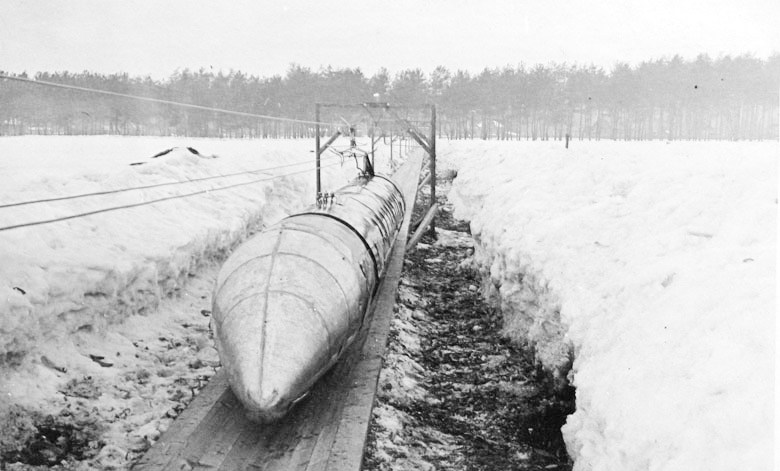
(Now stop that, it's silly. A little suspect, too, I think.)
Russians make some really cool shit. Sometimes - in fact, quite a lot of the time - it is the kind of shit that involves something going bang, whether it's blowing themselves up with airbags or making the biggest fucking nuke ever. But they also make a lot of cool shit that does not go bang, or at least isn't supposed to, and this page is about an example of the bangless variety, which came to my attention by way of this annoyingly brief mention.

In 1932 a Russian engineer named Nikolai Yarmolchuk (Yarmolshuk? It varies) began testing his new design of train, which was variously known as the "ball train", the "sphero-train", the "snake train", or "technically counts as a monorail I suppose". It was called these things because instead of on wheels it ran on huge steel balls, it looked like a snake, and the balls ran in a single guideway which in so far as it counts as a rail only counts as one. Unfortunately information on this interesting device is very thin on the ground, and even the great Douglas Self has not documented it. So here is some annoyingly incomplete stuff that I have managed to dig up.
The picture above is of an early test machine. The guideway is made of wooden baulks, presumably because it makes it easier to get a test rig up and running, arranged to form a trough; the pukka version was intended to run in a trough made from concrete. It is electrically powered from a three-phase supply collected via a rather hairy-looking pantograph arrangement; three-phase traction supplies (as originally proposed for the Metropolitan line of the London Underground, and used in some Swiss installations) usually simplify matters a bit by having one phase supplied via the track and only collecting two from the pantograph, but of course with a non-conducting guideway this does not work.
It looks fucking cold to be standing around outside playing with cold metal things. That's the problem with Russia: like Canada, you have to reckon on shit weather rendering a good half of the year totally fucked. It is said that the potential for snow and ice collecting in the guideway was one reason why they never got as far as a full size version, though I don't see why, as it looks as if a snowplough would if anything be easier to implement than on conventional track.

On the right is a picture of what is probably the next iteration of the prototype "sphero-train". It is evidently on a different part of the site (and in much less unpleasant weather) but still running on a wooden guideway. The overhead supply gear now appears to be made of self-supporting rigid members with some kind of wee trolley thing in place of a pantograph; it looks less spidery than the original arrangement but I have my doubts as to how freely it would run along the overhead tracks - though having said that it seems to work well enough to see it working.
The article from which that picture is taken contains some further details (and also yet another variant of the inventor's name; here he is "Yarmanchuk"). The sectional sketch shows that the ball-wheels are very large, occupying the full internal height of the train, with the centre-lines of the axles but little below the centre-line of the vehicle. Since the upper half of the train is just a shell, and the load of passengers, seating, drive machinery etc. is mostly in the lower half, the centre of gravity is below the point of suspension from the axles, and hence apparently is derived the stability.
A series of sketches at the bottom compares the Yarmolchuk design with other classes of monorail - the standard dangling type, the Brennan gyroscopically balanced design, and the Lartigue pannier system. The simplicity of both train and track in the Russian design compared to "conventional" types is apparent.
The article reckons the intended speed of the pukka version at 125mph. A disadvantage of the trough-shaped guideway is that any crap that falls into it will stay there, and one might wonder what happens if it hits a stone at that speed. Quite possibly the answer for a reasonable-sized stone is "not much"; a twelve-foot-diameter steel ball, even with a big hole in the middle, is going to be a pretty weighty object, and would probably just crush the stone while its mass and the suspension system would prevent appreciable shock being transmitted to the body. A boulder, of course, would be a different matter, but if it hit a boulder any kind of train would be fucked. The question is how the crossover point from "crush" to "fucked" compares with a conventional train. At least in Soviet Russia it would be unlikely to have to cope with bicycles and shopping trolleys and other such crap that gets chucked on the track by twats over here.
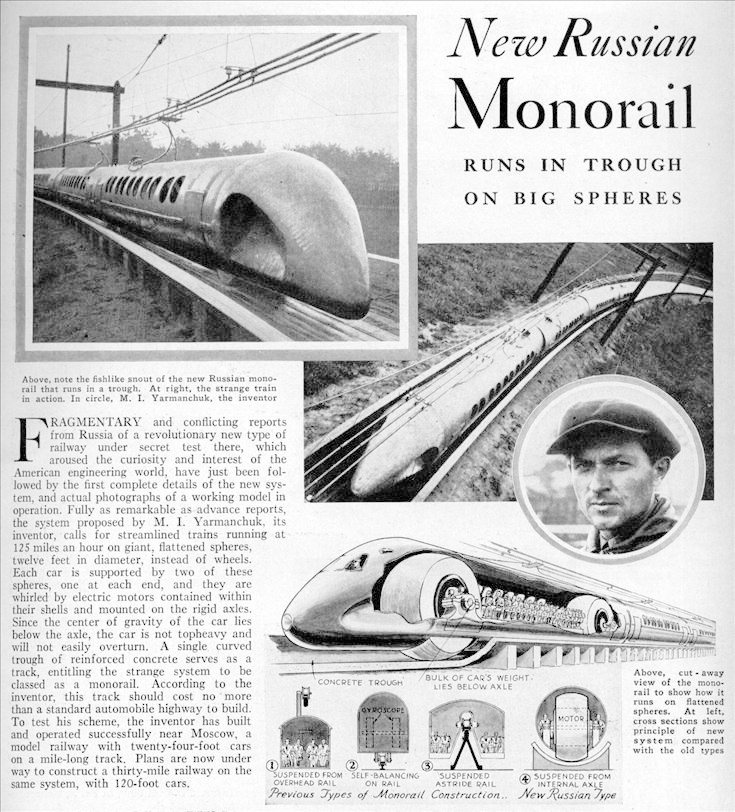
Nowhere is it explained what the two huge fuck-off holes at the front are for. The first prototype doesn't seem to have them, and on the later prototype they do look a bit as if they have been hacked in as an afterthought. They remind me of nothing so much as the air intakes on a Harrier, and the idea of jet propulsion, like this, is an intriguing thought, but where would be the exhaust? Certainly the prototype did not use it, and there is only the appearance of the holes to even suggest it.
Another article calls them "windows", but none of the photos suggest that there is any glass in them. No doubt the driver would have to look out somewhere but it would seem more logical to provide a proper cab entirely ahead of the front wheel, as the sketch in the previous article suggests; there would appear to be plenty of room in the nose cone for this on a full-size version, while on the prototype there was barely enough room for a driver to get inside at all and to see where he was going was a matter of sticking his head out of one of the side windows (as seen in a photograph further down this page).
This article also quotes an increased target speed of 190mph, and talks about the train being gyro-stabilised. I do not think that this is correct, nor is the inset diagram showing a "trough within a trough" and a much smaller ball wheel than the earlier article: it looks to me as if it has been cobbled together on the basis of a photo and an incomplete understanding of the facts.
There exists a short but fascinating video of the prototype under test. It is most frustrating not to be able to understand Russian. At one point there is a shot of one of the wheels standing alone in a section of track, being given a push to demonstrate that it is statically stable: the plain wobble that results does look as if there is no gyro involved, otherwise it would probably move in a much more funky manner.
The carriages exhibit a similar wobble as the train is going along. One would earnestly hope that some means had been found to damp this before putting a full size version into service, although it probably wouldn't really be much worse than a first generation DMU doing 70mph past Salwarpe on the down and hunting like a cunt.
Most interesting is the brief shot of two trains, one following the other at a fairly short but apparently constant distance. Presumably this is a reflection of the tendency of three-phase induction motors to run at a speed determined by the supply frequency. It does not look as if it represents a suitably safe method of working for service conditions!
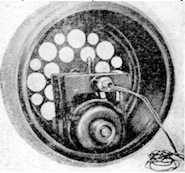
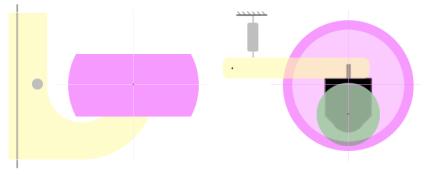
This interesting picture (right) shows the drive mechanism. The ball wheels are hollow, with one side open. There is no actual "axle" as such. A motor and gearbox assembly occupies the lower half of the space within the ball. A suspension arm comes in through the open side and engages with the pivot pin protruding from the top of the motor/gearbox assembly, in a manner reminiscent of a hub-centre front end on a motorbike. (I have added a sketch to make it clearer how the suspension works.) The gearbox drives a pair of wheels which run on the inside surface of the ball. The whole setup is very much like a normal powered bogie with a single axle, surrounded by a spherical shell which interfaces it to the grooved concrete track.
Here are a couple of pictures of Yarmolchuk with his prototype. The sudden intimation of scale provided by the sight of his head peering out of the window is quite disconcerting!
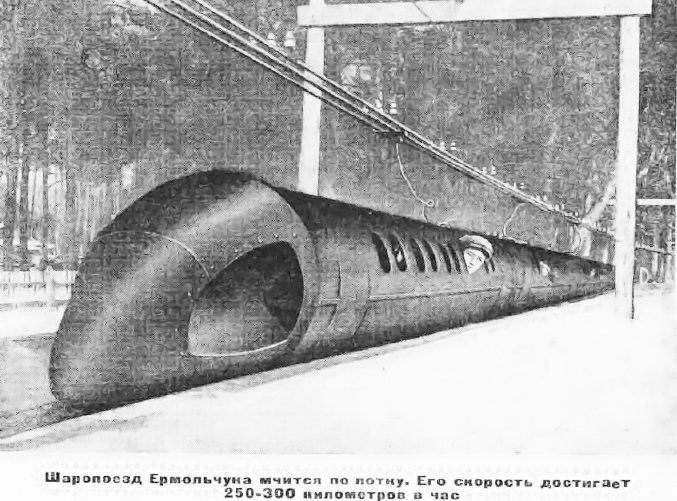
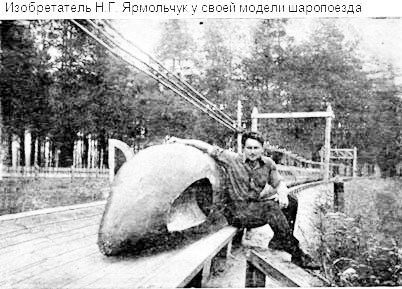
There is a page about it in the Russian wikipedia; this is what google translate makes of it:
Sharopoezd - Train monorail design, created by engineer NG Yarmolchukom 1932 in 1934 respectively . The train moved on spherical wheels with the built-in electric motors, which are located in a semi-circular gutters wooden platform (in full-scale project, the platform had to be concrete). A scale model (1/5) trains, built to test the concept of the vehicle speeds up to 70 km/h. It was assumed that the full-scale construction will reach speeds of 300 km/h.
Apparently, in the early 1930s, the USSR did not have sufficient production base for the implementation of such an ambitious project. From the project were a few museum pieces and newsreels of that era.
History
In March 1931 the People's Commissar V. Kuibyshev acquainted with the pilot plant, and in April Board of People's Commissariat of Railways decided as soon as possible to organize the production of prototype and test sharovagona sharodroma. Already in August 1933, the People's Commissars adopted a decree "On the construction of an experimental railway system Yarmolchuka NG towards Moscow - Noginsk." However, the problems inherent in all monorail system (high cost, complexity, arrows, etc.), as well as problems with icing gutters winter has not been resolved and the project within a few years of work canceled.
One of the recalled test: When I got into the narrow carriage, I was tormented by doubts. It seemed to me that the train in rapid should come off the tray, be sure to turn over. Nothing of the sort happened. Gently rocking slightly, without the usual clatter of iron wheels, the train swallowed space. The curves automatically bent, keeping balance, like a bicycle.
In 1933 the magazine "Ogonyok" dedicated to this project brief article.
Train on the ball
(20 October 1933)
Assembler Kursk road NG Yarmolchuk more in 1924 planned to apply to the transport of ball movement principle. I vaguely imagined it - it will shap, hollow ball inside which mechanisms necessary devices, people. Initially, therefore, the ball transport was quite utopian idea. Five years have passed. Former fitter was already a student, he studied at the Moscow Higher Technical School, and then at the MEI, and by 1929 the idea of ball-electro-bin transport finally matured. Cylindrical carriage has two support points in the two balls located under the car in front and behind. Developing a tremendous speed - up to 250-300 kilometers per hour - cars are not afraid of steep changes in the way the profile of "Roly-Poly", forcibly dumped immediately takes its normal position as soon as the external force is removed.
Following the report of the inventor in the SRT was created a special office with a staff of specialists. Given the extensive, specially fenced field experimental work. Released one million rubles. Create your own farm divorced vast garden of 15 hectares, there are growing cabbage, carrots, potatoes, cabbage ... Why? What garden? Soviet inventor and all his helpers in no way should not lack. Let them work without extraneous concerns.
89 people - engineers, technicians, fitters, carpenters, plumbers - build a wooden tray experienced, they build experimental ring length of 3 kilometers, they are preparing models of cars, small electrical substation. And now, in 1933, a happy thought Yarmolchuka tested and proven in practice.
You can get into a small trailer tin model. Lying you put in it. For convenience, in a toy wagon put a soft mattress. You do not rush in a straight line and a circle. The car is a little heel and then straightens "Roly-Poly" counteracts the centrifugal element.
If tin toy wagons rushing on simple wooden tray with a speed of 70 km per hour, so this performance can effectively train trhsotkilometrovuyu speed.
The idea of the invention has already been tested in the experimental laboratory ring. People's Commissars ordered the People's Commissariat this year to build a pilot operational road system Yarmolchuka companion - a stretch of road in the 20-25 km.
This is the usual attitude toward inventions, driving forward human culture, is being built in the country of socialism.
("Roly-Poly" is apparently Russian for a Weeble.)
Another machine-translated Russian article says:
Two-wheeled CARS flight on a thin rope
Since the construction of the first railways in them is nothing fundamentally changed. All the same two rails, sleepers. The development of railways could go a different path. Today, between Moscow and St. Petersburg through the channels, raised ten meters above the ground, rushed to streamline train more similar to airplanes; through the wide river, rather tysyachetonnyh bridges stretched to thin wires, which famously flew top two-wheeled wagons.
Usually unflappable Londoners turned their heads and hardly kept not to point the finger at the pavement. There, among the usual cabs and puffing samobeglyh wheelchair, rolled strange car. Like a bicycle or motorcycle, it had two wheels. But on this machine, in addition to the driver more comfortably accommodated three passengers. The car did not fall even at a low speed and confidently maneuvered among street traffic. But the car stopped. And do not even swayed neither left nor right. What's the trick?
The key to the stability of the miracle machine is simple - in heavy spinning gyroscope. That is top.
Hit the British unit built Pyotr Shilovsky, lawyer by education. Back in 1911, he presented to the public a tiny gyro model trains. Composition of several cars and the locomotive was moving briskly on one rail and fell even stops.
"Device for balance carts or other bodies" Shilovsky patented in Russia, England and Germany. The author pointed out that the gyroscope can be used in torpedoes, submarines, airplanes. Later, he added to this list of guns, spotlights...
The idea of gyroscopic trains belonged to the Englishman Louis Brennan, who before Shilovsky built such a car. But Shilovsky was sure that his design is thought out better and more suitable for mass production.
Kostroma Governor Shilovsky urged all - you need to build a full-size train with gyroscope inside. The heavy flywheel, once promoted, spinning a few hours. This is sufficient for a long travel from station to station, where you can unwind flywheel again. One rail instead of two - huge savings!
In the end, the governor sent a hectic sight in remote Olonets province. He stayed there a short time, resigned and went to England, where in 1914 built a gyroscopic cars. But Albion in his carriage looked like a fun ride. Shilovsky returned to Russia.
In 1919 he managed to convince the Soviet heads to continue the experiments. Gatchina between Petrograd and even began to build monorail road, but in the 22-year work ceased. On the fate of the inventor is not known.
Two years later, the baton noble madness caught engineer Nikolai Yarmolchuk. He also came up with two-wheeled wagons, but the problem of sustainability has decided otherwise. Each wheel of his train was a giant ball with a height of human growth. Marginalia balls - cut, here are the axis and an electric motor. Two of the world, "dressed" in the rubber, mounted in a cylindrical head and tail carriage. The balls protrude through slots in the bottom.
Way to sharopoezda Nicholas G. conceived as a concrete tray semi-circular shape, raised on poles above the ground. Streamlined sharopoezd should reach speeds of over 300 km/h. Yarmolchuk provided for in it, in addition to traditional, air brakes - retractable flaps.
In 1929, Nicholas G. tiny model built sharopoezda. Her action made a lasting impression on the boss - in Moscow organized a whole KB for the full length of the sample design.
In 1933 Yarmolchuk, along with new colleagues, built a working model of one more - five times less than the normal composition. Within these cars I have already placed a couple of people, though, lying.
Polished wooden trough bizarre snake wriggled among the birches near Moscow. One of the testers recalled: "When I got into the narrow carriage, I was tormented by doubts. I felt like a train in rapid should come off the tray, be sure to turn over. Nothing of the sort happened. Gently rocking slightly, without the usual clatter of iron wheels, the train swallowed space. The curves automatically bent, keeping balance, like a bicycle."
Yarmolchuk basked in the glory. Between Moscow and Noginsk we took was to build the first road trough, but then heard cries: "How much will it cost? And conventional railways have not yet revealed all its possibilities..." The venture quickly forgotten. Later Yarmolchuk worked as an engineer, but building such unusual design not break through.
Pledged in sharopoezd idea much later embodied in a variety of designs. Raised on columns and streamlined way, if planes, trains turned monorail, only a slightly different design than Yarmolchuka. Air brakes can now be found on the aircraft. A rubber-covered steel wheels - on trains, in many subways around the world. Himself sharopoezd remains a dream. ("Alphabet", January, No. 2)
An article from The Children's Newspaper (a creation of Arthur Mee, the "Children's Encyclopedia" chap) has this to say about it:
Yarmolchuk's invention is also interesting. Just in the same way that a bicycle maintains equilibrium in a single line, so the ball-bearing train runs uprightly in a groove.
The cars are streamlined in form, and run on motorised ball-bearings in a grooved concrete track. Each car rides on two large motorised balls 12 feet in diameter. On the axle of each ball is suspended a powerful but compact motor.
The motors remain stationary, but operate on the axle, thus revolving the balls, which propel the train with a minimum of lost power.
More Than 150 Miles an Hour
The balls are almost as high as the cars in which they are placed, thus giving the train a low centre of gravity. Each unit of the train has its own means of propulsion. Each car is to be 120 feet long and will accommodate 110 passengers.
When moving in the groove the cars are absolutely steady and maintain a stable equilibrium both when travelling in a straight line or taking curves.
The train can attain a speed of more than 150 miles an hour with the same amount of current consumed by an ordinary electric train. Transport reform is clearly in its infancy. We ourselves invented the locomotive, but we do not appear to be maintaining the lead in locomotive matters.
Its stability really has very little in common with the stability of a bicycle.
One presumes that the author of this article had not seen the film of the demonstration, in which the cars are clearly not "absolutely steady", nor the photo of the inside of the ball, as the description of how the drive works is clearly wrong.
It is sad that the article promotes to children the incorrect use of the term "ball bearing" to refer to a steel ball. A ball bearing is an assembly consisting of a number of balls rolling between races. A steel ball on its own is just a steel ball. I remember when I was 8 or so a friend had a steel ball the size of a marble which he insisted on calling a "ball bearing" and I was never able to get it through to him that it wasn't...
Someone (I don't know who) is still playing with the idea today and has produced a video, generated entirely from computer simulations, portraying an updated version which looks like nothing so much as a rather elaborate dildo. The blurb says:
The 'Wholetrain' is comprised of a skeletal structure, individual compartment cells and an exterior envelope.
The shape of the carriage has been optimised by undertaking wind tunnel experiments. This allows the Wholetrain to reach high speeds and reduces required energy.
The concept of the moving mechanism of the train is based on the research and design developed by Russian engineer Nikolay Yarmolchuk between 1932 and 1934, a monorail that can run on large spheres.
The spheres act as the main driving force whilst stabilising and acting as the train's center of gravity. This kind of mechanism provides stability whilst the train is in motion and helps avoid faults. It is estimated that speeds can reach 700 km/h making the Wholetrain one of the fastest and safest transnational means of transport.
It all sounds wonderful until you get to that "...estimated that speeds can reach 700km/h", which is the sort of phrase that means "pie in the sky"...
Back to Pigeon's Nest
Be kind to pigeons